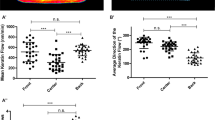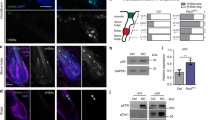Abstract
Cell growth, an increase in mass and size, is a highly regulated cellular event. The Akt/mTOR (mammalian target of rapamycin) signalling pathway has a central role in the control of protein synthesis and thus the growth of cells, tissues and organisms1. A striking example of a physiological context requiring rapid cell growth is tissue repair in response to injury2. Here we show that keratin 17, an intermediate filament protein rapidly induced in wounded stratified epithelia3, regulates cell growth through binding to the adaptor protein 14-3-3σ. Mouse skin keratinocytes lacking keratin 17 (ref. 4) show depressed protein translation and are of smaller size, correlating with decreased Akt/mTOR signalling activity. Other signalling kinases have normal activity, pointing to the specificity of this defect. Two amino acid residues located in the amino-terminal head domain of keratin 17 are required for the serum-dependent relocalization of 14-3-3σ from the nucleus to the cytoplasm, and for the concomitant stimulation of mTOR activity and cell growth. These findings reveal a new and unexpected role for the intermediate filament cytoskeleton in influencing cell growth and size by regulating protein synthesis.
This is a preview of subscription content, access via your institution
Access options
Subscribe to this journal
Receive 51 print issues and online access
$199.00 per year
only $3.90 per issue
Buy this article
- Purchase on Springer Link
- Instant access to full article PDF
Prices may be subject to local taxes which are calculated during checkout




Similar content being viewed by others
References
Kozma, S. C. & Thomas, G. Regulation of cell size in growth, development and human disease: PI3K, PKB and S6K. Bioessays 24, 65–71 (2002)
Martin, P. Wound healing—aiming for perfect skin regeneration. Science 276, 75–81 (1997)
Paladini, R. D., Takahashi, K., Bravo, N. S. & Coulombe, P. A. Onset of re-epithelialization after skin injury correlates with a reorganization of keratin filaments in wound edge keratinocytes: defining a potential role for keratin 16. J. Cell Biol. 132, 381–397 (1996)
McGowan, K. M. et al. Keratin 17 null mice exhibit age- and strain-dependent alopecia. Genes Dev. 16, 1412–1422 (2002)
Omary, M. B., Coulombe, P. A. & McLean, W. H. Intermediate filament proteins and their associated diseases. N. Engl. J. Med. 351, 2087–2100 (2004)
Bereiter-Hahn, J. in Biology of the Integument-Vertebrates (eds Bereiter-Hahn, J., Matoltsy, A. G. & Richards, K. S.) 443–463 (Springer-Verlag, New York, 1986)
DePianto, D. & Coulombe, P. A. Intermediate filaments and tissue repair. Exp. Cell Res. 301, 68–76 (2004)
Coulombe, P. A. & Wong, P. Cytoplasmic intermediate filaments revealed as dynamic and multipurpose scaffolds. Nature Cell Biol. 6, 699–706 (2004)
Mazzalupo, S., Wong, P., Martin, P. & Coulombe, P. A. Role for keratins 6 and 17 during wound closure in embryonic mouse skin. Dev. Dyn. 226, 356–365 (2003)
Hay, N. & Sonenberg, N. Upstream and downstream of mTOR. Genes Dev. 18, 1926–1945 (2004)
Fingar, D. C., Salama, S., Tsou, C., Harlow, E. & Blenis, J. Mammalian cell size is controlled by mTOR and its downstream targets S6K1 and 4EBP1/eIF4E. Genes Dev. 16, 1472–1487 (2002)
Hardie, D. G. The AMP-activated protein kinase pathway—new players upstream and downstream. J. Cell Sci. 117, 5479–5487 (2004)
Meijer, A. J. & Codogno, P. Regulation and role of autophagy in mammalian cells. Int. J. Biochem. Cell Biol. 36, 2445–2462 (2004)
Kabeya, Y. et al. LC3, a mammalian homologue of yeast Apg8p, is localized in autophagosome membrane after processing. EMBO J. 19, 5720–5728 (2000)
Sarbassov, D. D., Guertin, D. A., Ali, S. M. & Sabatini, D. M. Phosphorylation and regulation of Akt/PKB by the rictor-mTOR complex. Science 307, 1098–1101 (2005)
Prasad, G. L., Valverius, E. M., McDuffie, E. & Cooper, H. L. Complementary DNA cloning of a novel epithelial cell marker protein, HME1, that may be down-regulated in neoplastic mammary cells. Cell Growth Differ. 3, 507–513 (1992)
Fu, H., Subramanian, R. R. & Masters, S. C. 14-3-3 proteins: structure, function, and regulation. Annu. Rev. Pharmacol. Toxicol. 40, 617–647 (2000)
Brunet, A. et al. 14-3-3 transits to the nucleus and participates in dynamic nucleocytoplasmic transport. J. Cell Biol. 156, 817–828 (2002)
Liao, J. & Omary, M. B. 14-3-3 proteins associate with phosphorylated simple epithelial keratins during cell cycle progression and act as a solubility cofactor. J. Cell Biol. 133, 345–357 (1996)
Tzivion, G., Luo, Z. J. & Avruch, J. Calyculin A-induced vimentin phosphorylation sequesters 14-3-3 and displaces other 14-3-3 partners in vivo. J. Biol. Chem. 275, 29772–29778 (2000)
Ku, N. O., Michie, S., Resurreccion, E. Z., Broome, R. L. & Omary, M. B. Keratin binding to 14-3-3 proteins modulates keratin filaments and hepatocyte mitotic progression. Proc. Natl Acad. Sci. USA 99, 4373–4378 (2002)
Beck, T. & Hall, M. N. The TOR signalling pathway controls nuclear localization of nutrient-regulated transcription factors. Nature 402, 689–692 (1999)
Bertram, P. G., Zeng, C., Thorson, J., Shaw, A. S. & Zheng, X. F. The 14-3-3 proteins positively regulate rapamycin-sensitive signaling. Curr. Biol. 8, 1259–1267 (1998)
Li, Y., Inoki, K., Yeung, R. & Guan, K. L. Regulation of TSC2 by 14-3-3 binding. J. Biol. Chem. 277, 44593–44596 (2002)
Yaffe, M. B. et al. The structural basis for 14-3-3:phosphopeptide binding specificity. Cell 91, 961–971 (1997)
Coulombe, P. A., Tong, X., Mazzalupo, S., Wang, Z. & Wong, P. Great promises yet to be fulfilled: defining keratin intermediate filament function in vivo. Eur. J. Cell Biol. 83, 735–746 (2004)
Bernot, K. M., Coulombe, P. A. & Wong, P. Skin: an ideal model system to study keratin genes and proteins. Methods Cell Biol. 78, 453–487 (2004)
Redpath, N. T., Foulstone, E. J. & Proud, C. G. Regulation of translation elongation factor-2 by insulin via a rapamycin-sensitive signalling pathway. EMBO J. 15, 2291–2297 (1996)
Kim, D. H. et al. mTOR interacts with raptor to form a nutrient-sensitive complex that signals to the cell growth machinery. Cell 110, 163–175 (2002)
Staddon, J. M., Smales, C., Schulze, C., Esch, F. S. & Rubin, L. L. p120, a p120-related protein (p100), and the cadherin/catenin complex. J. Cell Biol. 130, 369–381 (1995)
Acknowledgements
We thank members of the Coulombe laboratory for support, B. Vogelstein for providing 14-3-3σ antibody and cDNA, T. Yoshimori for providing anti-LC3 antibody, and C. Parent, S. Craig, J. Lorsch, D. Ginty, S. H. Cha, S. Kim, C. S. Lee and C. Moon for advice. This work was supported by a grant from the National Institute of Arthritis, Musculoskeletal and Skin Diseases (NIAMS) to P.A.C.
Author information
Authors and Affiliations
Corresponding author
Ethics declarations
Competing interests
Reprints and permissions information is available at npg.nature.com/reprintsandpermissions. The authors declare no competing financial interests.
Supplementary information
Supplementary Figure Legends
This file contains text to accompany the below Supplementary Figures. (DOC 32 kb)
Supplementary Figure 1
Complement to analyses of K17 null keratinocytes. (JPG 427 kb)
Supplementary Figure 2
Additional analyses of Akt/mTOR pathway in K17 null keratinocytes (JPG 517 kb)
Supplementary Figure 3
Identification of 14-3-3σ as a keratin 17-binding protein. (JPG 1491 kb)
Supplementary Figure 4
Further analysis of the significance of the K17/14-3-3σ interaction for regulation of protein synthesis and growth in skin keratinocytes. (JPG 386 kb)
Rights and permissions
About this article
Cite this article
Kim, S., Wong, P. & Coulombe, P. A keratin cytoskeletal protein regulates protein synthesis and epithelial cell growth. Nature 441, 362–365 (2006). https://doi.org/10.1038/nature04659
Received:
Accepted:
Issue Date:
DOI: https://doi.org/10.1038/nature04659
This article is cited by
-
KRT13 promotes stemness and drives metastasis in breast cancer through a plakoglobin/c-Myc signaling pathway
Breast Cancer Research (2022)
-
Update of the keratin gene family: evolution, tissue-specific expression patterns, and relevance to clinical disorders
Human Genomics (2022)
-
Susceptibility of cytoskeletal-associated proteins for tumor progression
Cellular and Molecular Life Sciences (2022)
-
Translational control of stem cell function
Nature Reviews Molecular Cell Biology (2021)
-
Transcriptome analysis reveals the genetic basis underlying the development of skin appendages and immunity in hedgehog (Atelerix albiventris)
Scientific Reports (2020)
Comments
By submitting a comment you agree to abide by our Terms and Community Guidelines. If you find something abusive or that does not comply with our terms or guidelines please flag it as inappropriate.



